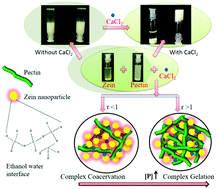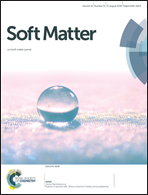Mixing ratio dependent complex coacervation versus bicontinuous gelation of pectin with in situ formed zein nanoparticles†
Abstract
We report on the competitive phenomenon of complex coacervation versus bicontinuous gelation between pectin (P, a polyanionic carbohydrate, [P] = 0.01–2% (w/v)) and zein nanoparticles (Z, a hydrophobic protein and a weak polyampholyte, [Z] = 0.1 and 0.5% (w/v), in an ethanolic solution of effective concentration 4 and 27% (v/v)), which was studied below (pH ≈ 4), and above (pH ≈ 7.4) the pI (≈ 6.2) of zein at room temperature, 25 °C. The uniqueness of this study arises from the interaction protocol used, where the pectin used was in the extended polyelectrolyte (persistence length ≈ 10 nm) conformation while zein was used as a charged globular nanoparticle (size ≈ 80–120 nm) that was formed in situ. Their mixing ratio, r = [P] : [Z] (w/w), was varied from 0.02 to 4.0 (for [Z] = 0.5% (w/v)), and from 0.1 to 7.5 (for [Z] = 0.1% (w/v)) in the ionic strength range 10−4 to 10−2 M NaCl. Zeta potential data revealed that at pH ≈ 4, the complementary binding condition, r = 1 : 1 (equivalent to 1 : 5 molecule/nanoparticle) demarcated the coacervate from the gel region. The measured rigidity (G0, low frequency storage modulus) of these materials revealed the following: for r < 1, (low pectin content samples, coacervate region) the material had lower values of Gcoac0, whereas for r > 1, an excess of pectin facilitated gelation with Ggel0 ≫ Gcoac0. Above pI, surface patch binding caused associative interactions and complex coacervation though both biopolymers had similar net charge. The network density was used as a descriptor to distinguish between the coacervate and gel samples. Their microstructures were probed by small angle neutron scattering (SANS), and viscoelastic properties by rheology. Simple modeling shows that formation of the interpolymer complex was favored in higher protein containing samples. Mixing ratio dependent selective coacervation (a kinetic process) and bicontinuous gelation (a thermodynamic process) are rarely seen to coexist in biopolymer interactions.

- This article is part of the themed collection: Complex Coacervation


 Please wait while we load your content...
Please wait while we load your content...